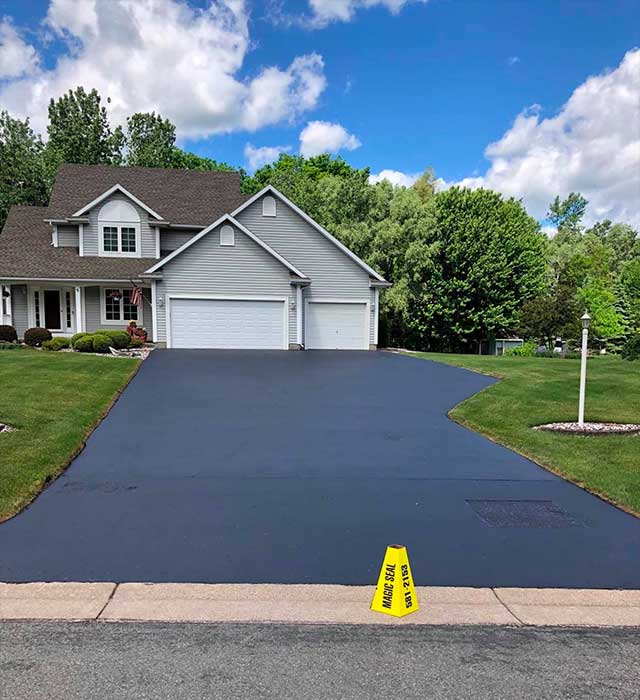Elevate Safety and Charm: Angled Parking Lot Solutions with Asphalt Sealing
Hot Mix Asphalt: A Lasting Option for Sidewalk
Hot Mix Asphalt (HMA) has emerged as a leading sustainable option for pavement remedies, providing a myriad of ecological advantages and ingenious innovations. As the demand for green building and construction techniques grows, exploring the subtleties of HMA's sustainability can give useful insights right into the future of sidewalk solutions.
Ecological Advantages of Warm Mix Asphalt

Additionally, Hot Mix Asphalt helps to minimize urban warm island impacts. Its dark shade absorbs sunshine, minimizing the quantity of heat reflected back into the atmosphere contrasted to lighter-colored pavements. This can decrease ambient temperatures in city areas, decreasing the demand for air conditioning and inevitably lowering power consumption.
Additionally, Warm Mix Asphalt adds to improved stormwater management. Its permeable nature enables water to infiltrate the pavement and reenergize groundwater products, lowering runoff and the risk of flooding. These ecological benefits make Hot Mix Asphalt a lasting selection for paving freeways and roads.
Energy Performance in HMA Manufacturing
Is power efficiency an essential variable in the manufacturing of Hot Mix Asphalt (HMA)? Energy plays a substantial duty in the production of HMA, influencing both cost and environmental sustainability. One crucial facet of energy efficiency in HMA manufacturing is the use of warm mix asphalt (WMA) modern technologies.
Furthermore, improvements in plant modern technologies have actually led to more energy-efficient HMA production procedures. By maximizing power usage in HMA production, the industry can reduce its carbon footprint while maintaining high-quality sidewalk materials.
Recyclability of Hot Mix Asphalt
The recyclability of Hot Mix Asphalt (HMA) is a pivotal element of its sustainability and long-term ecological impact. HMA is one of one of the most recycled materials in the United States, with over 100 million tons of recovered asphalt sidewalk (RAP) being recycled yearly in brand-new sidewalk building. Recycling HMA provides several environmental advantages, such as decreasing the demand for virgin products, reducing energy usage throughout manufacturing, and lowering the quantity of waste sent out to land fills.
The process of recycling HMA involves milling the existing pavement, crushing it right into smaller sized items, and blending it with brand-new accumulation and asphalt binder to develop a recycled mix. This recycled mix can usually carry out as well as or also much better than conventional HMA, while needing less basic materials and creating lower greenhouse gas emissions. By integrating RAP right into new pavement projects, road agencies can preserve all-natural sources, minimize expenses, and reduce the environmental impact of roadway building resource and construction and upkeep activities. Overall, the recyclability of HMA plays a significant role in advertising lasting methods within the pavement sector.

Long-Term Performance of HMA
Asphalt pavements show longevity and strength over an extended period, reflecting the long-term performance of Hot Mix Asphalt (HMA) The longevity of HMA can be attributed to its ability to withstand rush hour lots, harsh weather, and the results of aging. Researches have shown that well-designed and properly constructed HMA sidewalks can last for two decades or even more with routine maintenance. The key to taking full advantage of the long-lasting performance of HMA lies in making use of high-grade products, complying with best practices in building, and carrying out effective upkeep techniques. Proper drainage, routine assessments, and timely repairs are crucial for preserving the structural integrity of HMA sidewalks with time. In addition, improvements in HMA technology, such as making use of polymer-modified binders and warm mix her latest blog asphalt, have additionally improved the resilience and long life of HMA pavements. By prioritizing high quality construction and upkeep methods, HMA remains to verify itself as a sustainable and cost-efficient remedy for resilient pavement facilities.

HMA: Toughness and Sustainability
Showing both toughness and sustainability, Warm Mix Asphalt (HMA) has ended up being a cornerstone in the construction of durable pavement infrastructures - hot mix asphalt. HMA's durability originates from its capability to endure hefty lots, severe climate conditions, and high website traffic quantities, making it a dependable selection for roadways, freeways, and flight terminal paths. The composition of HMA, which typically consists of aggregates, binder, and filler, plays a vital duty in enhancing its durability and resistance to tear and use
In addition, HMA's sustainability lies in its recyclability and energy-efficient production procedure. The ability to reuse redeemed asphalt sidewalk (RAP) in new HMA blends decreases the demand for virgin materials and lessens the ecological impact of pavement building and upkeep. In addition, the energy effectiveness of creating HMA exists in its lower blending temperature levels compared to other sidewalk products, resulting in minimized power intake and greenhouse gas discharges.
Conclusion
In final thought, warm mix asphalt (HMA) provides a sustainable option for sidewalk with its ecologically friendly qualities. HMA's recyclability, energy effectiveness in manufacturing, and long-lasting durability make it an environmentally friendly selection for roadway building and construction. By preserving all-natural sources, lowering waste, and decreasing greenhouse gas exhausts, HMA plays an essential function in promoting sustainability in infrastructure development. Its ability to mitigate urban warm island impacts even more underscores its importance in website here creating resistant and eco aware pavement systems.
HMA is one of the most recycled products in the United States, with over 100 million bunches of reclaimed asphalt pavement (RAP) being recycled every year in brand-new pavement building and construction.The process of recycling HMA involves crushing the existing pavement, squashing it into smaller pieces, and blending it with brand-new accumulation and asphalt binder to develop a recycled mix.Asphalt pavements demonstrate resilience and resilience over an extensive period, showing the long-lasting performance of Warm Mix Asphalt (HMA) Additionally, improvements in HMA technology, such as the use of polymer-modified binders and cozy mix asphalt, have better boosted the resilience and durability of HMA sidewalks. The capacity to reuse redeemed asphalt pavement (RAP) in brand-new HMA mixes reduces the need for virgin products and reduces the ecological impact of sidewalk construction and maintenance.